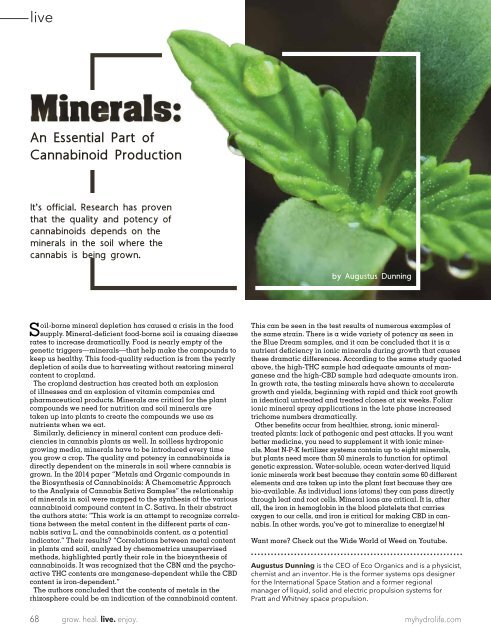Hydrolife Magazine August/September 2016 (USA Edition)
Welcome to the third edition of the new Hydrolife. At this point, all we can say is “wow”. The response from readers, industry professionals and those who use cannabis to heal themselves has blown away all expectations. When we started Hydrolife with a medicinal cannabis theme, our intent was to connect growers, medical practitioners, patients and health enthusiasts by providing information related to this powerful plant. As we continue to do that, it is becoming apparent that passion in the medicinal cannabis revolution runs deep.
Welcome to the third edition of the new Hydrolife. At this point, all we can say is “wow”. The response from readers, industry professionals and those who
use cannabis to heal themselves has blown away all expectations. When we started Hydrolife with a medicinal cannabis theme, our intent was to connect
growers, medical practitioners, patients and health enthusiasts by providing information related to this powerful plant. As we continue to do that, it is becoming apparent that passion in the medicinal cannabis revolution runs deep.
Create successful ePaper yourself
Turn your PDF publications into a flip-book with our unique Google optimized e-Paper software.
live<br />
An Essential Part of<br />
Cannabinoid Production<br />
It’s official. Research has proven<br />
that the quality and potency of<br />
cannabinoids depends on the<br />
minerals in the soil where the<br />
cannabis is being grown.<br />
by <strong>August</strong>us Dunning<br />
Soil-borne mineral depletion has caused a crisis in the food<br />
supply. Mineral-deficient food-borne soil is causing disease<br />
rates to increase dramatically. Food is nearly empty of the<br />
genetic triggers—minerals—that help make the compounds to<br />
keep us healthy. This food-quality reduction is from the yearly<br />
depletion of soils due to harvesting without restoring mineral<br />
content to cropland.<br />
The cropland destruction has created both an explosion<br />
of illnesses and an explosion of vitamin companies and<br />
pharmaceutical products. Minerals are critical for the plant<br />
compounds we need for nutrition and soil minerals are<br />
taken up into plants to create the compounds we use as<br />
nutrients when we eat.<br />
Similarly, deficiency in mineral content can produce deficiencies<br />
in cannabis plants as well. In soilless hydroponic<br />
growing media, minerals have to be introduced every time<br />
you grow a crop. The quality and potency in cannabinoids is<br />
directly dependent on the minerals in soil where cannabis is<br />
grown. In the 2014 paper “Metals and Organic compounds in<br />
the Biosynthesis of Cannabinoids: A Chemometric Approach<br />
to the Analysis of Cannabis Sativa Samples” the relationship<br />
of minerals in soil were mapped to the synthesis of the various<br />
cannabinoid compound content in C. Sativa. In their abstract<br />
the authors state: “This work is an attempt to recognize correlations<br />
between the metal content in the different parts of cannabis<br />
sativa L. and the cannabinoids content, as a potential<br />
indicator.” Their results? “Correlations between metal content<br />
in plants and soil, analyzed by chemometrics unsupervised<br />
methods, highlighted partly their role in the biosynthesis of<br />
cannabinoids. It was recognized that the CBN and the psychoactive<br />
THC contents are manganese-dependent while the CBD<br />
content is iron-dependent.”<br />
The authors concluded that the contents of metals in the<br />
rhizosphere could be an indication of the cannabinoid content.<br />
This can be seen in the test results of numerous examples of<br />
the same strain. There is a wide variety of potency as seen in<br />
the Blue Dream samples, and it can be concluded that it is a<br />
nutrient deficiency in ionic minerals during growth that causes<br />
these dramatic differences. According to the same study quoted<br />
above, the high-THC sample had adequate amounts of manganese<br />
and the high-CBD sample had adequate amounts iron.<br />
In growth rate, the testing minerals have shown to accelerate<br />
growth and yields, beginning with rapid and thick root growth<br />
in identical untreated and treated clones at six weeks. Foliar<br />
ionic mineral spray applications in the late phase increased<br />
trichome numbers dramatically.<br />
Other benefits occur from healthier, strong, ionic mineraltreated<br />
plants: lack of pathogenic and pest attacks. If you want<br />
better medicine, you need to supplement it with ionic minerals.<br />
Most N-P-K fertilizer systems contain up to eight minerals,<br />
but plants need more than 50 minerals to function for optimal<br />
genetic expression. Water-soluble, ocean water-derived liquid<br />
ionic minerals work best because they contain some 60 different<br />
elements and are taken up into the plant fast because they are<br />
bio-available. As individual ions (atoms) they can pass directly<br />
through leaf and root cells. Mineral ions are critical. It is, after<br />
all, the iron in hemoglobin in the blood platelets that carries<br />
oxygen to our cells, and iron is critical for making CBD in cannabis.<br />
In other words, you’ve got to mineralize to energize!<br />
Want more? Check out the Wide World of Weed on Youtube.<br />
<strong>August</strong>us Dunning is the CEO of Eco Organics and is a physicist,<br />
chemist and an inventor. He is the former systems ops designer<br />
for the International Space Station and a former regional<br />
manager of liquid, solid and electric propulsion systems for<br />
Pratt and Whitney space propulsion.<br />
68<br />
grow. heal. live. enjoy.<br />
myhydrolife.com




![Hydrolife Magazine December 2017/January 2018 [CANADIAN EDITION]](https://img.yumpu.com/59790088/1/190x247/hydrolife-magazine-december-2017-january-2018-canadian-edition.jpg?quality=85)
![Hydrolife Magazine December 2017/January 2018 [USA EDITION]](https://img.yumpu.com/59790042/1/190x247/hydrolife-magazine-december-2017-january-2018-usa-edition.jpg?quality=85)
![Hydrolife Magazine October/November 2017 [Canada Edition]](https://img.yumpu.com/59493562/1/190x247/hydrolife-magazine-october-november-2017-canada-edition.jpg?quality=85)
![Hydrolife Magazine October/November 2017 [USA Edition]](https://img.yumpu.com/59493548/1/190x247/hydrolife-magazine-october-november-2017-usa-edition.jpg?quality=85)
![Hydrolife Magazine August/September 2017 [USA Edition]](https://img.yumpu.com/59236656/1/190x247/hydrolife-magazine-august-september-2017-usa-edition.jpg?quality=85)









